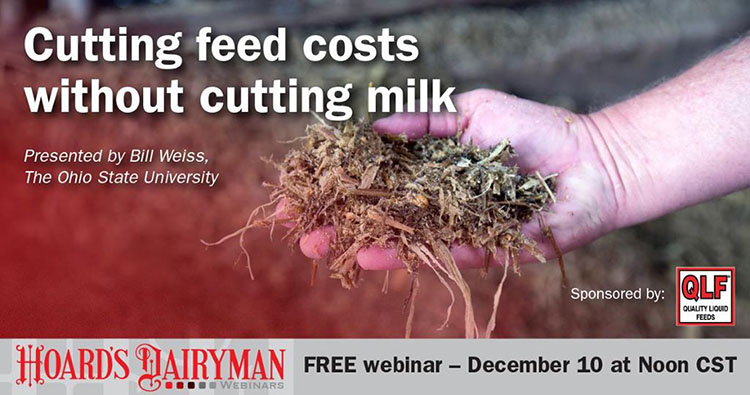
We are familiar with the concept of more milk equals more income. However, if additional milk comes with higher expenses, it may not be profitable. In periods of tighter margins, taking the time to evaluate the ration and looking for places to fine-tune ingredients without forfeiting production is a sound investment.
Bill Weiss, The Ohio State University, discussed “Cutting feed costs without cutting milk” during the December Hoard’s Dairyman webinar.
When evaluating feeds to include in a ration, he said to determine the cost of the nutrient in the feed, not just the cost of the feed. What is it providing to the cow, and what is that cost?
Weiss described “bargain feeds” as those that have a higher nutrient value than market price dictates. These included corn grain, corn silage, corn gluten feed, dried distillers grains (DDG), expeller soybean meal (SBM), hominy, whole cottonseed, and wheat midds. However, feeds determined to be “overpriced” may have intrinsic value that is needed by the cow, such as the lysine found in blood meal or the sugar found in molasses. The quality of alfalfa hay is a huge factor in determining if its nutrients are worth the expense. Other feeds on this overpriced list include canola meal-expellers, canola meal-solvent, fishmeal, and tallow.
Consistent feed quality has an impact as well. It can affect production and feed efficiency. Regardless of the price paid for hay, moldy feed is not a bargain. It either should be discarded if inedible or if it is not going to give your cows the best chance to convert that subpar feed into top production. This also applies to homegrown feed. You may not have written a check for it, but if the quality is low, production will suffer.
Weiss stressed, “Yield beats average-quality feed, but great quality beats yield.” What he was referencing was that if you want four cutting of alfalfa versus three, you will have more yield. But, if the quality is just average, you may have wasted time and resources making that fourth cutting.
If you are feeding a high-quality feed in very low amounts, you might be wasting your dollars. However, “High-quality feed fed at a high ration inclusion rate is worth it,” stated Weiss.
When cows are grouped by production needs you can better manage your feed inputs. He demonstrated that feeding three rations (as compared to one ration) allowed the ingredients to be better balanced per group. The most productive cows were reaching their potential, while the lower producers were not wasting feed.
All groups considered, it was a difference of 8 pounds per cow that could be saved by grouping and feeding for production. The downside is that more labor is needed to manage the pens as well as preparing and managing three rations.
Weiss encouraged producers to feed to nutrient requirements or overformulate just a bit, rather than underfeed. “It can be quite expensive in the long run,” he said. “Vitamins and minerals can be overfed up to 20 percent, but not more.”
Feed additives can be beneficial in rations. However, only thoroughly vetted research should be considered. And, some additives work better in certain farm situations. The true cost of additives should be evaluated on your farm. Remember that some additives may work better in early lactation cows rather than for mid-lactation cows, or for younger cows compared to older ones. Money spent on additives should be focused on the cows that see the greater (or greatest) return.
Wasted feed and shrink can deplete feed inventories. Spoiled silage has the same purchase cost as top-notch forage when it is in your bunk. Preserve it to maximize quality. Weather can play a role as wet distillers grains can spoil after just two weeks. Wet feeds are not stable and can impact palatability. Protect and cover dry hay to minimize spoilage and shrink.
While we often tell children to eat everything they are offered at mealtime, cows should not eat to an empty bunk. It might indicate that there is not enough feed available to them, and that they could be eating more feed and therefore producing more milk. However, excessive amounts of feed should not remain once all the cows have eaten. “Three to 5 percent weigh backs is very achievable,” concluded Weiss.
The link to the archived webinar is at on.hoards.com/WB_121018. The presentation was sponsored by QLF. This webinar and all previous ones can be found at hoards.com/webinars.
Join us next month:

Dairy policy analyst Mark Stephenson, from the University of Wisconsin-Madison, presents “The dairy situation and outlook for 2019” on Monday, January 14, at noon (Central time).
For the past four years, dairy markets have been stuck in a relatively small range of prices that don’t cover the full costs of production for most producers. Will 2019 be the breakout year that we hope it is? We’ll examine the market fundamentals we face and see what’s in store. The January webinar is sponsored by Chr. Hansen.
Register at www.hoards.com/webinars.

The author is the online media manager and is responsible for the website, webinars, and social media. A graduate of Modesto Junior College and Fresno State, she was raised on a California dairy and frequently blogs on youth programs and consumer issues.